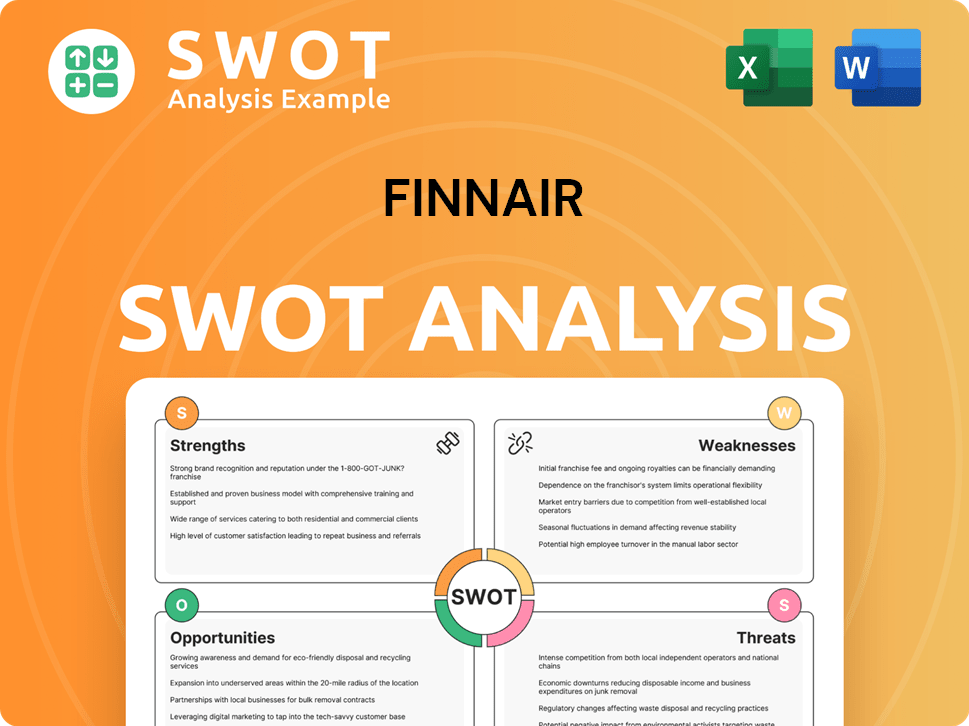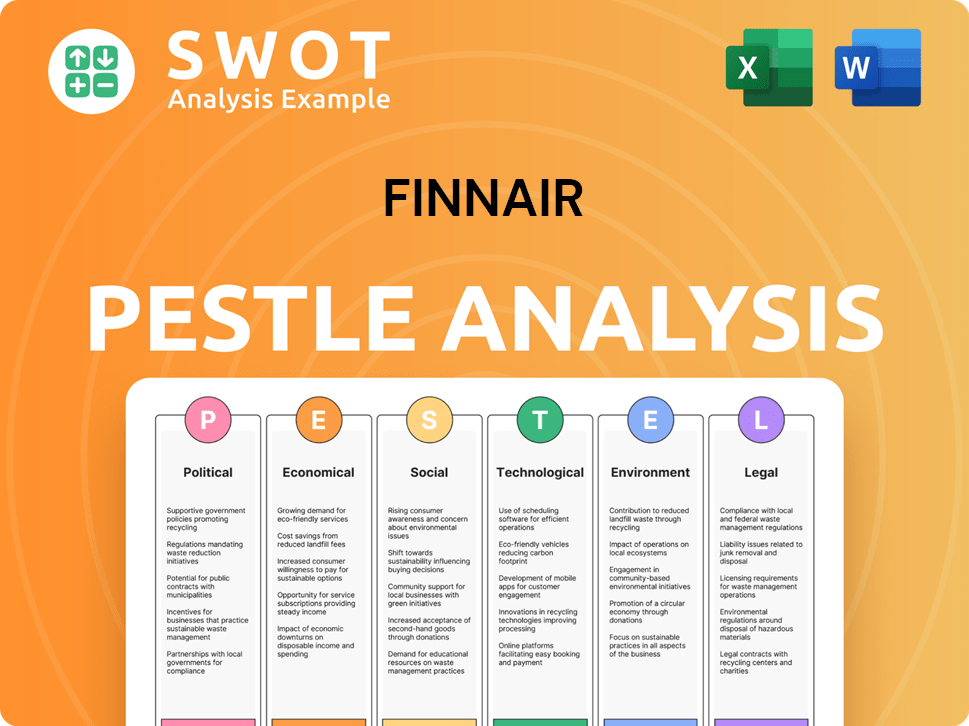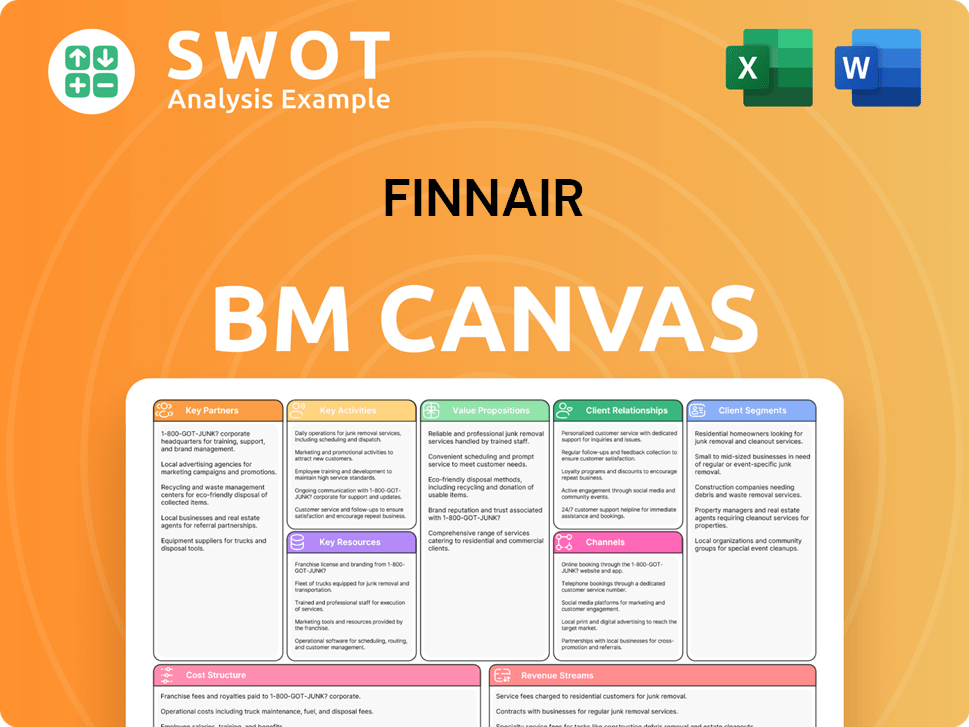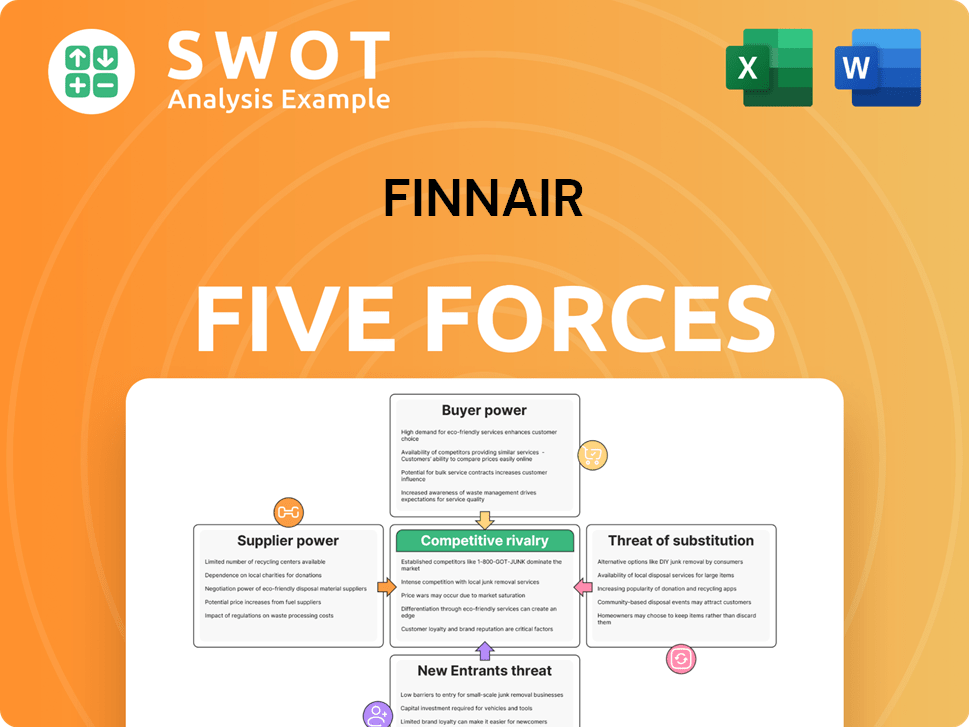Finnair Bundle
How Does Finnair Navigate the Turbulent Skies of the Aviation Industry?
The global aviation sector is constantly evolving, and Finnair, the flag carrier of Finland, operates within this dynamic environment. Established in 1923, Finnair has grown from a regional airline to a key player connecting Europe and Asia. Understanding the Finnair SWOT Analysis is crucial to grasp its position in this competitive arena.

This exploration of the Finnair competitive landscape will analyze its market position and key competitors, providing a detailed Finnair market analysis. We'll examine Finnair's strategy, competitive advantages, and the challenges it faces in the airline industry Finland. This analysis will also cover Finnair's main rivals, financial performance, and how it responds to industry challenges, offering insights into its future growth plans and aviation market share.
Where Does Finnair’ Stand in the Current Market?
Finnair's market position in the European aviation sector is defined by its strategic focus on connecting Europe and Asia, primarily through its Helsinki hub. This positioning is crucial for understanding the Revenue Streams & Business Model of Finnair. The airline's core operations encompass passenger and cargo transport, with scheduled flights, charter services, and air cargo operations forming its primary product lines. Its geographic presence is concentrated on long-haul routes to Asia and North America, complemented by an extensive European network.
The airline caters to a diverse customer base, including business travelers, tourists, and cargo clients. Over time, Finnair has emphasized efficiency, punctuality, and high service standards, particularly on long-haul routes. This approach allows it to serve both premium and budget-conscious travelers through differentiated service offerings. Finnair's strategy also involves digital transformation initiatives to enhance customer experience and operational efficiency, aiming to strengthen its competitive edge in the airline industry in Finland.
In 2023, Finnair reported a comparable operating result of EUR 228.6 million, a significant improvement from the previous year, showing a strong recovery post-pandemic. The net debt at the end of 2023 stood at EUR 730.7 million, with a comparable return on capital employed of 14.7%. These financial results, alongside its strategic focus, suggest a resilient market position, even amid fluctuating fuel prices and geopolitical uncertainties.
The Finnair competitive landscape is shaped by its focus on connecting Europe and Asia, particularly through its Helsinki hub. This strategic focus allows it to compete effectively in the aviation market share. The airline's main rivals include major European and Asian carriers that operate on similar routes.
Finnair serves business travelers, tourists, and cargo clients. The airline's route network analysis reveals a strong presence in long-haul routes to Asia and North America, complemented by European feeder flights. This diversified customer base is crucial for its financial performance compared to competitors.
Finnair emphasizes efficiency, punctuality, and high service standards, especially on long-haul routes. This allows it to cater to both premium and budget-conscious travelers. Digital transformation initiatives are also key to enhancing customer experience and operational efficiency.
In 2023, Finnair reported a comparable operating result of EUR 228.6 million, improving from the previous year. The net debt was EUR 730.7 million, and the comparable return on capital employed was 14.7%. These figures indicate a resilient market position despite global aviation challenges.
Finnair's competitive advantages include its strategic location in Helsinki, which serves as a convenient hub for connecting Europe and Asia. Its focus on efficiency, punctuality, and high service standards also sets it apart. These advantages contribute to Finnair's SWOT analysis and overall strategic positioning.
- Strategic Hub Location: Helsinki's geographical advantage for connecting Europe and Asia.
- Service Quality: Emphasis on punctuality and high standards, especially on long-haul routes.
- Operational Efficiency: Continuous efforts to improve operational processes and customer experience.
- Financial Performance: Demonstrated ability to recover and improve financial results post-pandemic.
Finnair SWOT Analysis
- Complete SWOT Breakdown
- Fully Customizable
- Editable in Excel & Word
- Professional Formatting
- Investor-Ready Format

Who Are the Main Competitors Challenging Finnair?
The Finnair competitive landscape is shaped by a dynamic interplay of direct and indirect competitors. The airline operates in a market characterized by intense competition, particularly on routes between Europe and Asia. Understanding these competitive pressures is essential for assessing Finnair's strategic positioning and future prospects.
Finnair's market analysis reveals a complex web of rivals, from established European flag carriers to rapidly expanding Asian airlines. The airline's ability to navigate this environment, leveraging its strengths and adapting to market changes, is crucial for its success. The competitive landscape also includes the influence of alliances and the emergence of new industry players.
Finnair faces a multifaceted competitive environment. Direct competitors include major European airlines and prominent Asian carriers. Indirect competition comes from budget airlines within Europe, impacting Finnair's feeder traffic. The airline's strategy is also influenced by its membership in the Oneworld alliance.
Direct competitors primarily include established European flag carriers and major Asian airlines. These airlines compete directly with Finnair on routes, especially between Europe and Asia. They offer extensive networks and compete on price, service, and connectivity.
Key European rivals include Lufthansa, Air France-KLM, and British Airways (IAG). These airlines have significant market share and extensive route networks, often competing directly on price and service quality. They also benefit from strong brand recognition and loyalty programs.
Asian carriers, such as Singapore Airlines, Cathay Pacific, and Emirates, pose a substantial challenge. They leverage strong hub connections and often competitive pricing for intercontinental travel. These airlines are known for their premium services and extensive route networks.
Turkish Airlines is a significant competitor, aggressively expanding its network and offering competitive pricing. This expansion challenges Finnair's market share on some routes, especially through its Istanbul hub. Turkish Airlines' growth has been notable in recent years.
Indirect competitors include budget airlines within Europe, such as Ryanair and easyJet. While not directly competing on long-haul routes, they can impact Finnair's feeder traffic by offering cheaper alternatives for intra-European travel. This affects the overall passenger flow.
The rise of new long-haul low-cost carriers could also present future challenges. These airlines offer lower fares, potentially impacting Finnair's pricing strategies. However, their prevalence has been less significant post-pandemic.
The airline industry is influenced by alliances and mergers. Finnair's membership in the Oneworld alliance helps it compete by offering a broader network and shared loyalty programs, countering the reach of Star Alliance and SkyTeam members. Mergers and alliances constantly reshape the competitive environment.
- Alliances: Finnair's Oneworld membership provides a competitive advantage.
- Mergers: Industry consolidation affects market dynamics.
- Emerging Players: Sustainable aviation and new technologies could disrupt the landscape.
- Sustainability: Focus on environmental initiatives is becoming increasingly important.
- Technology: Adoption of new technologies influences operational efficiency and customer experience.
Finnair PESTLE Analysis
- Covers All 6 PESTLE Categories
- No Research Needed – Save Hours of Work
- Built by Experts, Trusted by Consultants
- Instant Download, Ready to Use
- 100% Editable, Fully Customizable

What Gives Finnair a Competitive Edge Over Its Rivals?
Understanding the Owners & Shareholders of Finnair is crucial for assessing its competitive standing. Finnair's competitive advantages stem from its strategic location, operational efficiency, and strong brand reputation. These factors enable the airline to maintain a strong position in the aviation market, particularly in its niche connecting Europe and Asia.
Finnair's strategic moves and operational excellence are central to its competitive edge. The airline focuses on providing shorter flight times and fuel-efficient operations. Furthermore, its commitment to customer satisfaction and sustainability enhances its appeal in a competitive market.
The airline's ability to adapt to market changes and technological advancements is critical. Finnair continually enhances its digital services and customer experience, ensuring its advantages remain sustainable. However, it faces challenges from competitors and broader industry shifts.
Finnair's Helsinki Airport hub offers shorter flight times between Europe and Asia. This 'Northern route' advantage reduces travel time, making Finnair attractive to passengers. The airline's location provides a strategic advantage in the competitive landscape.
Finnair is known for its high punctuality rates and efficient turnaround times. This operational excellence enhances customer satisfaction and cost-effectiveness. Efficient operations are key to maintaining a competitive edge in the airline industry.
Finnair has a strong brand built on Finnish design, comfort, and passenger well-being. This fosters customer loyalty, particularly among its core segments. A strong brand is a significant competitive advantage.
Finnair leverages its membership in the Oneworld alliance to expand its global reach. This offers seamless connections and benefits to frequent flyers. Alliances are crucial for competing in the global aviation market.
Finnair's competitive advantages are multifaceted, encompassing its strategic location, operational efficiency, and brand reputation. These elements collectively enhance its market position. The airline's ability to adapt and innovate is vital for sustained success.
- Geographic Position: The Helsinki hub offers shorter routes between Europe and Asia.
- Operational Efficiency: High punctuality and efficient turnaround times improve customer satisfaction.
- Brand Equity: Strong brand associated with Finnish design and passenger comfort.
- Alliance Membership: Oneworld alliance expands global reach and benefits.
Finnair Business Model Canvas
- Complete 9-Block Business Model Canvas
- Effortlessly Communicate Your Business Strategy
- Investor-Ready BMC Format
- 100% Editable and Customizable
- Clear and Structured Layout

What Industry Trends Are Reshaping Finnair’s Competitive Landscape?
The Finnair competitive landscape is significantly influenced by industry trends, future challenges, and growth opportunities. The aviation sector is currently navigating technological advancements, regulatory changes, and evolving consumer preferences. Understanding these factors is crucial for assessing Finnair's strategic positioning and future prospects in the Airline industry Finland.
Finnair's market analysis reveals a complex environment shaped by geopolitical tensions, economic shifts, and intensifying competition. The company faces risks such as volatile fuel prices and the need to invest in sustainability, while also seeking to capitalize on opportunities in emerging markets and through strategic partnerships. Its ability to adapt and innovate will be key to maintaining its market share and financial performance compared to competitors.
The airline industry is undergoing significant shifts. Technological advancements in sustainable aviation fuels (SAFs) and fuel-efficient aircraft are critical. Regulatory changes, such as stricter emission targets, are also impacting the aviation market share and operational costs.
Finnair faces challenges including managing volatile fuel prices and navigating geopolitical uncertainties. Intensifying competition from both traditional and emerging carriers is another significant hurdle. The long-term impact of climate change concerns on air travel also poses a challenge.
Significant growth opportunities exist in emerging markets, particularly in Asia. Product innovations, such as enhanced in-flight connectivity, can drive customer loyalty. Strategic partnerships, especially within the Oneworld alliance, offer avenues for network expansion.
Finnair's strategy involves optimizing its route network, investing in sustainable solutions, and enhancing its digital capabilities. The company aims to restore its operating result to a sustainable level and continue its long-term growth. The Helsinki hub is a key strategic asset.
Finnair's recent strategic moves include adapting to the closure of Russian airspace, impacting its Asia strategy. The company is focusing on profitable segments and leveraging its Helsinki hub. Understanding Finnair's competitive advantages is crucial.
- Sustainability: Investing in SAFs and reducing emissions.
- Network Optimization: Focusing on profitable routes and the Helsinki hub.
- Digital Capabilities: Enhancing online services and customer experience.
- Partnerships: Leveraging the Oneworld alliance for network expansion.
Finnair Porter's Five Forces Analysis
- Covers All 5 Competitive Forces in Detail
- Structured for Consultants, Students, and Founders
- 100% Editable in Microsoft Word & Excel
- Instant Digital Download – Use Immediately
- Compatible with Mac & PC – Fully Unlocked

Related Blogs
- What are Mission Vision & Core Values of Finnair Company?
- What is Growth Strategy and Future Prospects of Finnair Company?
- How Does Finnair Company Work?
- What is Sales and Marketing Strategy of Finnair Company?
- What is Brief History of Finnair Company?
- Who Owns Finnair Company?
- What is Customer Demographics and Target Market of Finnair Company?
Disclaimer
All information, articles, and product details provided on this website are for general informational and educational purposes only. We do not claim any ownership over, nor do we intend to infringe upon, any trademarks, copyrights, logos, brand names, or other intellectual property mentioned or depicted on this site. Such intellectual property remains the property of its respective owners, and any references here are made solely for identification or informational purposes, without implying any affiliation, endorsement, or partnership.
We make no representations or warranties, express or implied, regarding the accuracy, completeness, or suitability of any content or products presented. Nothing on this website should be construed as legal, tax, investment, financial, medical, or other professional advice. In addition, no part of this site—including articles or product references—constitutes a solicitation, recommendation, endorsement, advertisement, or offer to buy or sell any securities, franchises, or other financial instruments, particularly in jurisdictions where such activity would be unlawful.
All content is of a general nature and may not address the specific circumstances of any individual or entity. It is not a substitute for professional advice or services. Any actions you take based on the information provided here are strictly at your own risk. You accept full responsibility for any decisions or outcomes arising from your use of this website and agree to release us from any liability in connection with your use of, or reliance upon, the content or products found herein.